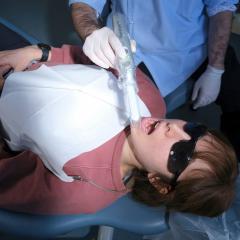A red LED light could be key to making a trip to the dentist a pain-free, needle-free experience.
LED-light therapy, that combines red light and infrared light, is being clinically trialled by University of Queensland researchers across 15 Queensland dental clinics in Brisbane, Gold Coast, Sunshine Coast and Toowoomba.
Dr Jessica Zachar from UQ’s School of Dentistry said about 900 patients were expected to take part in the trial that would assess how effective the red LED – or light emitting diode – was in preventing and reducing pain for commonplace dental procedures.
“Approximately 30 per cent of Australians avoid dental visits due to fear of needles,’’ Dr Zachar said.
“This could immensely help patients who may have previously delayed going to the dentist because of the fear of pain.’’
The trial uses a type of light treatment called photo-biomodulation, with a device called Nuralyte™ that was invented, designed and developed by Australian start-up company Dentroid.
The non-invasive device works by sending light through soft tissues in the mouth and teeth, blocking the pain signals along nerves that transmit pain for approximately 15-20 minutes.
Nerves that transmit touch and other sensations are not affected, so the area does not feel numb or tingling.
“A previous clinical trial conducted at Griffith University demonstrated that the device was very successful at reducing pain for dental injections within the mouth when compared to traditional numbing gel,’’ Dr Zachar said.
“The UQ trial takes the next step forward by integrating this device into everyday dental practice for a wider range of dental procedures.’’
Four clinical trials are running simultaneously for 4 common dentistry procedures: for use prior to dental injections, to make the needle pain free; to reduce sensitivity during dental cleans; for small fillings so they can be needle free; and to reverse/shorten the duration of local anaesthesia at the end of the appointment.
Further trials planned later this year will test the device for reducing pain after dental extractions.
UQ School of Dentistry Emeritus Professor Laurence Walsh said photo-biomodulation has already been widely used in other fields of health including the treatment of chronic pain conditions in medicine, veterinary practice and physiotherapy.
“It is hoped this treatment also becomes standard practice for a range of dental procedures in dentistry,’’ Professor Walsh said.
“We hope the technology will be widely available for all dentists to use in 2026.’’
The technology is safe for adults and children aged 6 and above with parental/guardian consent.
The clinical trial continues until October. For information contact Dr Zachar at: j.zachar@uq.edu.au


